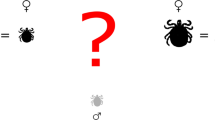Abstract
A selection of the 10% lightest and 10% heaviest males and females of a population of individually weighed Rhipicephalus appendiculatus Neumann adults was made in two experiments. The offspring of homologous pairs were followed until the next adult stage (light x light, control x control and heavy x heavy). The engorged nymphal weights, unfed adult weights, engorged female weights of the parents, egg mass weights, egg weights, larval scutal lengths, engorged larval weights, unfed nymphal weights, engorged nymphal weights and adult weights of the progeny were determined. No significant differences could be demonstrated between the two lines for egg weight, larval scutal length, engorged larval weight and unfed nymphal weight. Significant differences were found between the egg masses, engorged nymphal weights and adult weights of the two lines. The heritability coefficients of body weight determined from adult to adult were 0.14 and 0.10, respectively, during the first and second experiments. Considering females and males separately, the coefficients were 0.10 and 0.18 during the frist experiment and 0.12 and 0.09 during the repeat experiment respectively.
Similar content being viewed by others
References
Arthur, D.R. and Snow, K. 1966. The significance of size in the immature stages of the Ixodidae. Parasitology, 56: 391–397.
Berkvens, D.L. 1990. A study on the ecology of the Rhipicephalus appendiculatus complex with special reference to the Eastern province of Zambia. PhD thesis, Brunel University, Uxbridge.
Berkvens, D.L., Pegram, R.G. Brandt, J.R.A. 1995. A study of the diapausing behaviour of Rhipicephalus appendiculatus and R. zambeziensis under quasi-natural conditions in Zambia. Med. Vet. Entomol. 9: 307–315.
Bradford, M.J. and Roff, D.A. 1993. Bet hedging and the diapause strategies of the cricket Allonemobius fasciatus. Ecology 74: 1129–1135.
Bradford, M.J. and Roff, D.A. 1995. Genetic and phenotypic sources of life history variation along a cline in voltinism in the cricket Allonemobius socius. Oecologia 103: 319–327.
Chiera, J.W., Newson, R.M. and Cunningham, M.P. 1985. The effect of size on feeding and breeding performance of Rhipicephalus appendiculatus Neumann. Insect Sci. Appl. 6: 555–560.
Mousseau, T.A. and Roff, D.A. 1989. Adaptation to seasonality in a cricket: patterns of phenotypic and genotypic variation in body size and diapause expression along a cline in season length. Evolution 43: 1483–1496.
Norval, R.A.I., Lawrence, J.A., Young, A.S., Perry, B.D., Dolan, T.T. and Scott, J. 1991. Theileria parva:influence of vector, parasite and host relationship on the epidemiology of theileriosis in southern Africa. Parasitology 102: 347–356.
Noryal, R.A.I., Perry, B.D. and Young, A.S. 1992. The Epidemiology of Theileriosis in Africa. Academic Press, London.
Payne, R.C. and Purnell, R.E. 1975. The effect of induced activity on the survival of the brown ear tick Rhipicephalus appendiculatus under laboratory conditions. Bul. Animal Health Product. in Afr. 23: 297–301.
Pegram, R.G. and Banda, D.S. 1990. Ecology and phenology of cattle ticks in Zambia: development and survival of free-living stages. Exp. Appl. Acarol. 8: 291–301.
Roff, D. 1981. On being the right size. Am. Nat. 118: 405–422.
Winston, P.B. and Bates, D.H. 1960. Saturated solutions for the control of humidity in biological research. Ecology 41: 232–237.
Author information
Authors and Affiliations
Rights and permissions
About this article
Cite this article
Madder, M., Torreele, G. & Berkvens, D. Inheritance of weight in Rhipicephalus appendiculatus ticks (Acari: Ixodidae) in the laboratory. Exp Appl Acarol 20, 659–665 (1996). https://doi.org/10.1007/BF00053329
Received:
Revised:
Accepted:
Issue Date:
DOI: https://doi.org/10.1007/BF00053329




